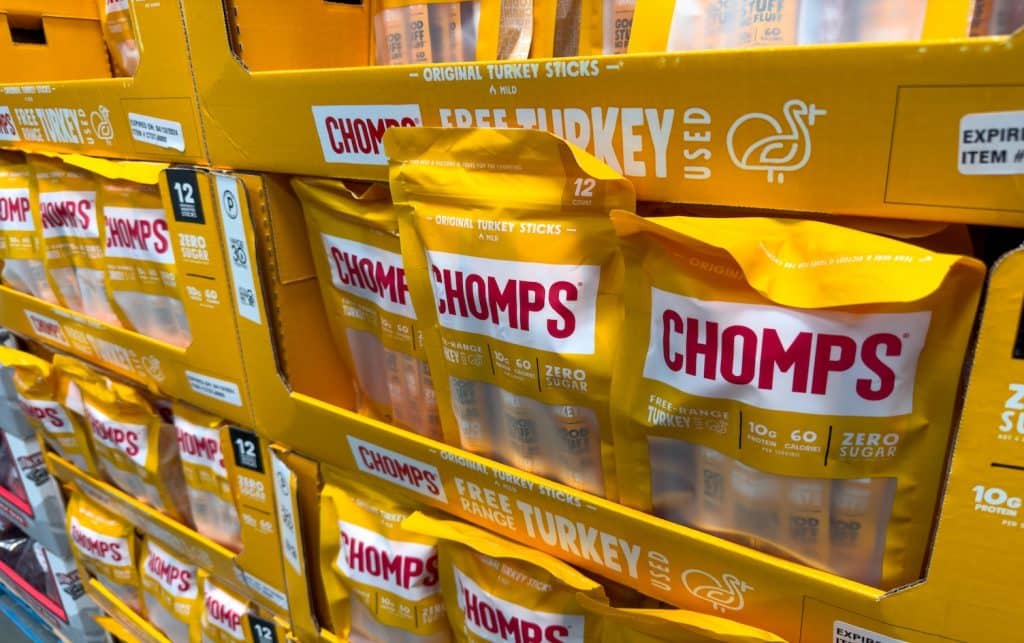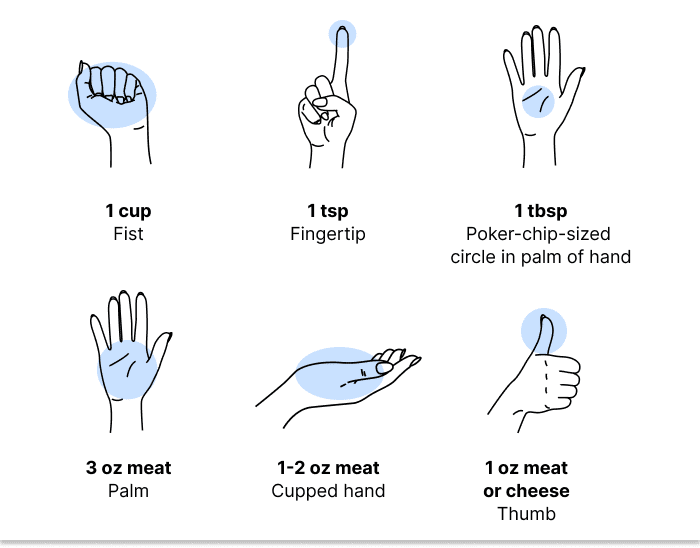Are you tired of second-guessing your portion sizes, wondering whether you’re eating too much or too little? You’re not alone!
Portion control is essential to maintaining a healthy lifestyle, and it’s high time we take the mystery out of knowing how much to eat. In this guide, we’re digging into the science of portion control and giving you five easy ways to manage your food intake. Time to discover the secrets to a balanced and healthy diet!
Understanding Food Portions
It turns out that we’re better at eating everything on our plates than our mothers thought we were. So, if we overserve ourselves too often, we may end up gaining unwanted weight. That’s why we’re giving you the scoop on portion sizes, and why taming them can be your secret weapon against overeating.
What’s the difference between portion and serving sizes?
Before we discuss portion control strategies, we need to clear up the difference between portion and serving sizes.
- Serving size: A standardized amount used for nutritional information
- Portion size: The amount of food you choose to eat
You know those nutrition facts labels you find on the back of every food package? Think of them like cheat codes for deciphering what you’re eating. The serving size is the recommended amount for one serving. Whether it’s a cup of cereal, a piece of chicken, or a handful of nuts, the serving size sets the stage for the rest of the nutritional details.
Sizes of foods can be so inconsistent—just think about the last piece of fruit you ate—so having standard serving sizes makes sense. If you eat a larger portion, you need to do some math to determine what you’re actually consuming.
For example, suppose you’re making a sandwich with two slices of bread. Look at the bread’s nutrition facts label. If it says that a serving size is only one slice, you’ll need to double the calories, sugar, etc. to accurately track what you’re eating.
Can you lose weight by cutting portion sizes?
Wondering if downsizing your portions can help you lose weight? Good news: It absolutely can! If you consume fewer calories than what your body needs, your body taps into its stash of stored fat. That means you’ll be burning fat, which leads to weight loss.
Scientific studies consistently support the idea that reducing portion sizes for weight loss can make a difference. This proves it’s not only about quality—although that’s important, too—but also about quantity. Just don’t cut too many that you’re body goes into “starvation mode.”
Can you gain weight by increasing portions?
On the flip side, consistently consuming larger portions can help if you’re trying to gain weight. When you up your portions, you’re giving your body more fuel to work with, which can help you pack on those desired pounds.
The key is to make sure you’re increasing portions with nutritious, calorie-dense foods to support your overall health while achieving your weight gain goals. Think hearty servings of healthy fats, lean proteins, and complex carbohydrates to help you gain weight in a healthy way.
5 Easy Ways To Calculate and Control the Size of Your Portions
Portion control is a secret ingredient in your recipe for a healthier lifestyle. So, let’s explore five effective ways to master the art of portion control to manage your intake of calories, essential macronutrients, and micronutrients.
1. Use a small plate as a portion control guide
Here’s how to fill your plate for healthy portion control:
- Vegetables: Fill half your plate with colorful raw or cooked vegetables. You can mix in a small portion of fruit on this half of the plate, too.
- Proteins: Reserve a quarter of the plate for lean meats like chicken or other protein foods like beans.
- Carbohydrates: The remaining quarter can be dedicated to whole grains or starchy vegetables.
Choosing a smaller plate that measures 9 inches (23 cm) across may help you keep portions in check..
2. Avoid eating directly from food packages
Ever find yourself mindlessly munching straight from a bag of chips? Guilty as charged, right? Getting those snacks onto a plate or into a bowl can help.
By portioning your snacks, you’re controlling calories without depriving yourself. This simple step prevents you from losing track of how much you’re eating.

You might also like:
11 High-Protein Foods to Pick Up at Costco >
3. Measure a balanced diet’s portions using your hand
Say hello to your built-in visual portion size guide, aka your hands! Turns out they’re pretty clever when it comes to estimating portions. Let’s break it down with an average adult fist in mind:
- Proteins: The palm of your hand is an ideal serving size of meat or a plant-based protein portion.
- Fruits and vegetables: Aim for a fist-sized fruit portion or starchy veg, but a portion of vegetables like leafy greens can be a bit larger.
- Carbohydrates: For your pasta, rice, or quinoa, a single portion is about one cupped handful.
- Fats: Limit fats to the tip of your finger.
Using your hand as a rough guide at every meal simplifies portion control and helps you keep tabs on the types of macronutrients (carbs, proteins, fats) your body needs for overall health.
You can even use your hand to approximately figure out the serving sizes you’ll find on a Nutrition Facts label without digging out the measuring cups:
- 1 cup: your fist
- 1 tsp: your fingertip
- 1 tbsp: poker-chip-sized circle in the palm of your hand
- 3 oz (of meat): the palm of your hand
- 1-2 oz (of meat): cupped hand
- 1 oz (of meat or cheese): your thumb

4. Outsmart restaurant portions by cutting them in half
Let’s face it – sometimes restaurant portions are notorious for being on the larger side. But don’t fret! There are ways to enjoy eating out while avoiding overeating and feeling bloated.
First things first, use the tips in this article to determine what your body needs. If you feel the portion you’re served is larger than what you need, box it up and take it home!
Splitting up a restaurant meal whatever way you want helps prevent unintentional calorie overload and gives you delicious leftovers for the next day. Less cooking? Yes, please!
5. Use a food diary or tracking app to control calorie intake
Harness the power of your smartphone to keep your calorie intake in check. We’re already glued to our phones all day anyway, right? So why not put that screen time to good use?
Fun fact: In 2023, MyFitnessPal members logged 4,889 meals per minute
Using a food diary app like MyFitnessPal is one of the best weight loss apps and fitness apps, helping nearly 1 million members reach their nutrition and fitness goals every year. Members use it as a calorie tracker and calorie counter to log their foods, and take advantage of the app’s food database that contains 18 million foods. It’s not just a free calorie counter app — it’s also the best calorie counter app for people who are looking to take back control of their health and fitness.
The Bottom Line
Let’s talk about keeping that scale in check while still enjoying your food! It’s like having your cake and eating it too — well, maybe just a thinner slice.
The secret is balancing your plate with a mix of tasty foods in just the right portions.
We’re not here to say, “Ditch this, ditch that.” It’s all about the variety. Why is this mix of foods so essential? It’s like giving your body a VIP pass to all the nutrients it craves. And it also keeps your taste buds happy!
Depriving yourself of what you crave can backfire, leading to that frustrating cycle of yo-yo dieting. By giving your body what it needs and what you want, all in the right portions — and keeping track! — you can lose weight sustainably.
Losing weight and maintaining a healthy weight isn’t about diet misery or locking up your favorite snacks. It’s about making friends with lots of different types of foods, keeping those portions in check, and living your best life.
Originally published December 20, 2017; Updated April 17, 2024







20 Responses
Oh Boy, I’m going hungry. Those portions are way too small for my size.
No, portions are just too big anymore. It’s one of the main reasons why so many Americans are fat!
Very true
I thought the same thing, thinking the portions sound too little for me. But it is very true what you said portions are just too big now. Now we are used to that.
While it is true portion sizes are too large, it is also true that a larger person (due to fat or muscle) needs to consume more calories. They shouldn’t necessarily increase portions of food, but increase frequency of consumption and number of healthy, diverse portions of food. So you and the original poster are partially correct. If the OP is larger then they are correct in thinking that this isn’t enough food, but also wrong in that they are thinking of it in terms of this one meal needing to fill them up. They should instead stick to portion sizes but add in healthy snacks. Even if they are trying to lose weight, they still need to maintain a healthy calorie balance.
I feel the same way. It’s too small but if you combine other foods within the portion size, and do this until you reach your calorific goal, then you can lose weight and feel full too
Would love a printer friendly version that I could take on the run to read.
Me too! Please make it printable.
Or build it into the native app as a ‘portion guide’ under the ‘more’ menu prompt? I’d imagine the dev team could do this almost as quickly as having to rewrite exclusive print-css markup.
Please reconsider your classification of zucchini. It is low in carbs and in calories, an excellent veggie to add volume and flavor to soups and other dishes.
I wish weight measurements were included.
So part of my problem is that I’m meal prepping, working out, so my appetite is THROUGH THE ROOF!! I try to do proper portioning, but it leaves me still very hungry. Eh…I guess such is life.
Are you adjusting for the calories you burn in your workout? I know I definitely use to forget to do that. Also sounds like you may need to up your protein. But, I’m definitely not a registered dietitian so take it with a grain of salt!
Are these recommendations based on cooked or raw? I know that cooking can change the nutrients, including the calories. This especially so with pasta and rice, where water is absorbed after cooking, so the raw amount differs from the cooked amount.
What is the healthy recommended intake of brown/red/black rice?
I definitely need to exercise portion control. I frequently dish out the same portions to myself as I do to my husband, who is twice my size. I read the best way to do this is to eat from a smaller plate.
hi I had that problem too. What I did to solve this was I don’t bring the food to the table any more or fix his plate. I put it on the counter nice and pretty and he can get what he wants himself.
Why is Zucchini on the starchy veg list?
This makes no sense at all. What if a person who is the same size in height and weight etc but one has larger hands,so one gets more than the other? My sister and I are near enough the same size and weight but her hands are larger than mine,my hands are small. I would be starving if I went by these portion sizes. I do not measure veg that grows above ground at all. I have lost quite a bit of weight this way.
what is 1 serving of rice in myfitnesspal app. I really do’t know how to translate 1 serving to cup measurements.
Thanks for sharing the article. The guide explains beautifully how one can easily proportionate their foods into right way to get maximum health benefits.